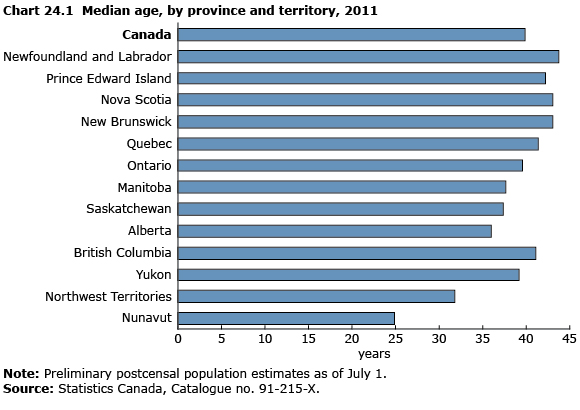Population and demography
Archived Content
Information identified as archived is provided for reference, research or recordkeeping purposes. It is not subject to the Government of Canada Web Standards and has not been altered or updated since it was archived. Please "contact us" to request a format other than those available.
Related information
On July 1, 2011, Canada's population was estimated at 34.5 million, up 356,600 people from the same date a year earlier. This represents a 1.0% increase, slightly lower than the 1.2% growth observed during the previous year.
Prince Edward Island, the western provinces and Nunavut all had growth rates above or equal to the national average. The largest provincial increases were in Prince Edward Island (1.7%) and Alberta (1.6%).
The median age of the population was 39.9 years, up 0.2 years. The Canadian population is aging because fertility rates are persistently below the replacement level and life expectancy is increasing.
Canada's aging population
As of July 1, 2011, the number of seniors (aged 65 and older) was estimated at just under 5.0 million, up 0.3 percentage points from July 1, 2010. Almost 1.4 million of those were aged 80 and older. Seniors' share of the population—14.4%—will grow more rapidly in the coming years as the first generation of baby boomers reaches the age of 65. However, the proportion of children (those under the age of 15) in the population decreased to 16.4%, or 5.6 million.
Newfoundland and Labrador had the highest median age (43.8 years) and the highest increase (0.5 years) in median age from July 2010. The median age in the other Atlantic provinces was also above the national average: 42.2 years in Prince Edward Island, 43.1 years in Nova Scotia and 43.0 years in New Brunswick. Nova Scotia and New Brunswick had the highest proportion of seniors, at 16.5% and 16.2%, respectively.
Quebec's population was older than the national average; the median age was 41.4 years and 15.7% of the population were seniors. For the first time, Quebec now has more seniors (1.3 million) than children (1.2 million). By contrast, Ontario's population was younger than that of Canada on July 1, 2011; the median age was 39.6 years and 14.2% of the population were seniors.
On July 1, 2011, only two provinces had a younger median age than they did in July 2010: Manitoba, 37.6 years, and Saskatchewan, 37.3 years. These two provinces also had the highest proportions of children—18.8% in Manitoba and 19.0% in Saskatchewan.
Alberta had the youngest population among the provinces with a median age of 36.0 years and a proportion of seniors at 10.8%—both figures were the lowest among all the provinces.
British Columbia was the only province west of Ontario whose median age was higher than that of the country as a whole, 41.1 years. Its proportion of seniors was 15.3%, the highest among the western provinces. British Columbia was also the only province in western Canada with more seniors (700,500) than children (684,900).
Youngest population resides in Nunavut
As of July 1, 2011, the youngest population in Canada lived in Nunavut, where the median age was 24.8 years. Almost a third (31.5%) of the Nunavut population was under the age of 15, the highest proportion in the country.
The Northwest Territories' population was also younger than the national average, with the median age at 31.8 years and 21.2% of the population under the age of 15. Among the territories, Yukon had the oldest population. Its median age was 39.2 years and the proportion of seniors was 8.8%.
Slight rise in fertility
Canada's total fertility rate was 1.67 children per woman in 2009, compared with 1.68 in 2008 and 1.49 in 2000. Over the decade, the sharpest percentage point gains were 4.6% in 2007 and 2.8% in 2006.
The total fertility rate in 2009 also remained lower than the generation replacement level of 2.1 children per woman. This is the fertility rate that must be maintained to replace the population in the absence of migration.
The highest fertility rates in the country were in Nunavut (3.24 children per woman) and in the Northwest Territories and Saskatchewan (both 2.06). The lowest fertility rates were in British Columbia and Nova Scotia (both 1.50).
In 2009, 380,863 babies were born in Canada, up 0.8% from the year before and the seventh consecutive annual increase. The advance, however, was lower than the 2.7% increase in 2008 and 3.7% in 2007.
The number of births increased in most regions, with the largest percentage increases occurring in Nunavut (8.9%), Saskatchewan (3.7%) and Yukon (2.7%). The largest decrease occurred in Nova Scotia (2.2%), followed by Prince Edward Island (1.8%), the Northwest Territories (1.4%), Ontario (0.3%) and New Brunswick (0.1%).
- Date modified:

